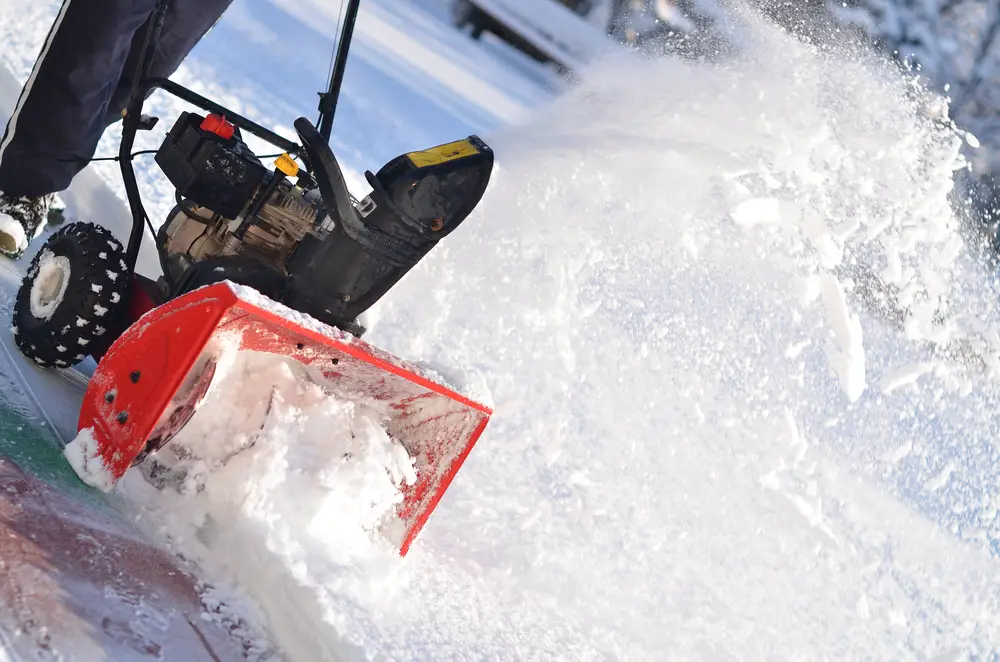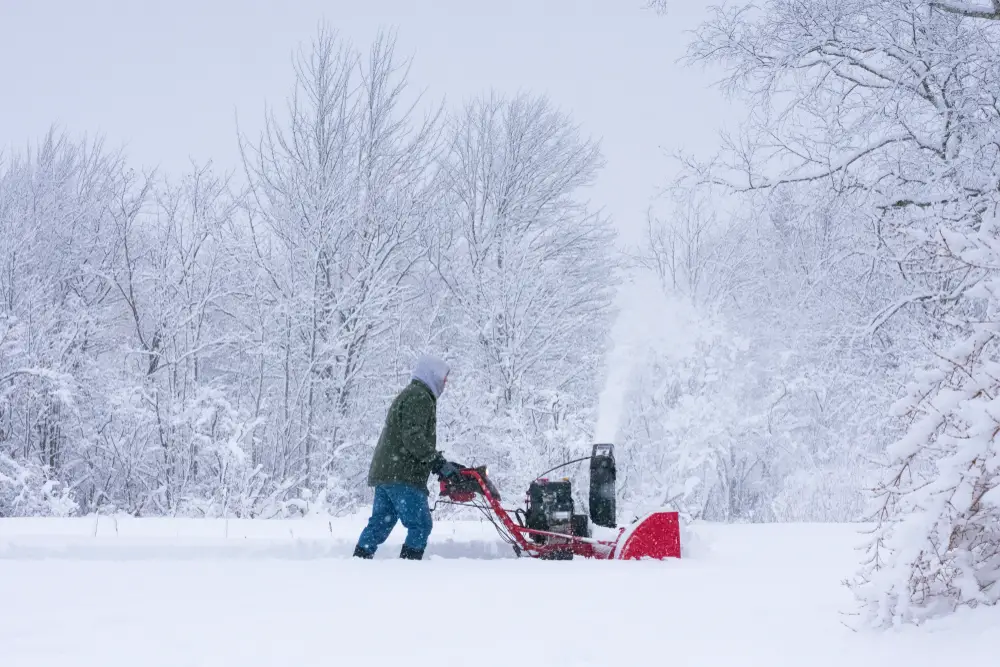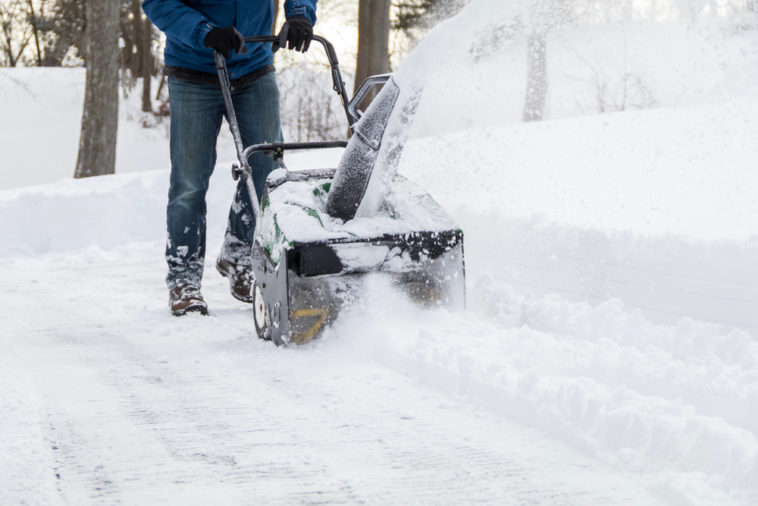There are many ways to remove snow from your driveway and walkway during winter. You can opt for the good old-fashioned snow shovel or pay a company to come and plow it out for you.
If you are looking for an option in between, a snow blower might be the best solution. However, if you don’t know how this machine works, you might not be able to get the most out of it when you use it.
That’s why we created this in-depth guide about snow blowers and how they work. So, let’s take a look.
How Do You Use a Snow Blower?
Snow blowers reduce the physical exertion required to remove accumulated snow from your space. Whether you are trying to clear out your home driveway or make it easier to travel down the sidewalk in front of your house, this machine can easily get the job done.
To use a snow blower, all you need to do is set it up, start it up, and begin pushing it where you want it to go.
Yes, really, that is it. It couldn’t get any simpler than that, right? Okay, there is a little more to this than just pressing go, but not much. But before learning about how snow blowers work, you will need to know how they are made.

Parts of a Snow Blower
Snow blowers have numerous parts critical to keeping the machine in working order. Each part is just as important as the next when it comes to keeping your snow blower internally functioning at the appropriate pace.
There are four main parts of a snow blower, and each has its own pieces that make it run.
The Auger Parts and Pieces
The auger is the main portion of the snow blower that scrapes up the snow with multiple blades and projects it into the chute, which gets pushed out of the machine and tossed into a pile. This portion of the snow blower has four main components.
- Sheer pin: The sheer pin is essential in keeping the blades of the augur rotating; if the pin were to break, the whole process would break down.
- Auger belt: The auger drive belt is connected to the control panel and the rotation pulley. This belt is what allows the control shaft to guide the auger.
- Skid shoes: The skid shoes work as a form of protection for the housing unit of the snow blower. These shoes sit on the ground and move along with the machine, keeping it from dragging and getting damaged.
- Scraper blades: The scraper blades take care of the snow and ice left behind by the auger blades. These blades are attached to the back and bottom part of the housing unit so they can do their job while you move.
- Chute: The chute is the tunnel portion of the snow blower, where the snow is sent up from the ground and pushed to a new location.
The blades inside the auger are usually made from metal or durable plastic. While metal is a little stronger, plastic holds up better in harsh weather conditions and won’t rust.
The auger’s blades will also vary in design depending on the brand you purchase. The most popular design is the helix, where the blades are horizontal and twist into a helix pattern. These blades go across the entire length of the auger.
You will also find designs with a corkscrew-shaped blade or even single blades, often used to chop up hunks of hard ice.
The Important Engine Parts
The engine is the heart behind the machine. Without a working engine, the snow blower doesn’t do a thing. You must maintain many essential engine parts to get quality work from your product.
- Starter: The starter is the portion of the machine that gets the engine going. The two main types of starters are crank and electric.The crank starters can be a little more complicated and tend to break down over time.
- Fuel filter: The fuel filter collects debris that makes its way into the engine fuel line. This debris can break down your oil over time, causing it to clog and damage your snow blower.
- Carburetor: The carburetor mixes the right amount of air with the machine’s fuel. The proper combination will create a usable combustion of gas that powers through a cylinder where a piston compresses it, and a spark plug ignites it.
The Important Drive Parts
The drive parts are the parts of the machine that make it move. There are only three main components: the motion drive belt, the friction disc, and the wheel plate.
- Friction disc and wheel plate: The friction disc sits on the same axle next to the drive wheel. The drive wheel plate moves along with the front wheel as the friction disk moves, keeping the snow blower driving smoothly forward.
- Motion drive belt: The motion drive belt is a belt that connects to the ground drive pulley located on the engine’s crankshaft and the drive wheel plate. These spin the wheel plate while the engine is running.
The Important Control Parts
Now it is time to control the snow blower. You do this mainly with cables and a gearbox that connects everything together.
- Auger engagement cable: This cable connects the auger control to the cable on the control box.
- Ground drive cable: The ground drive cable connects the control panel’s actuator lever to the drive wheel.
- Chute deflector cable: This cable connects the chute deflector to the control box to move the deflectors up and down.
- Chute control gearbox: The chute control gearbox manages the snow blower shoot. The joystick rotates the chute, allowing you control over the discharge.

Features of a Snow Blower
A lot of working parts on a snow blower are necessary for the machine to do its job.
Now that we have gone through all those critical pieces and you have a good understanding of how they work, let’s take a look at some features that aren’t required but will make the job easier to handle.
Headlights
Technically you don’t need headlights on your snow blower to use it and for it to properly clear out your driveway and sidewalk. However, this feature is fantastic, especially for those who work during the day and only have the night or early morning to remove accumulated snow.
Multiple Speeds
A basic snow blower will only come with one speed. This setback can be frustrating, especially when the snow isn’t all that heavy, and it shouldn’t take so long to make a path.
Multiple speeds will keep this issue under control and allow you to get the job done on your own time.
Heated Hand Grip
Pushing the snow blower up and down the driveway can be painful enough; pairing it with freezing-cold hands can make it an unbearable chore.
Consider purchasing a snow blower that offers heated hand grips to keep you from feeling cold and frustrated clearing the snow.
Single Hand Steering
While you should never multi-task when snow-blowing (like texting or talking on the phone), having a single-handed handlebar can be very efficient, freeing up your unused hand to control the chute.
An Accelerator
The accelerator does precisely what it sounds like: it accelerates the clearing of the snow. This portion will take the snow and force it into the discharge housing of the snow blower to quickly get things moving. This can also be referred to as a multi-stage snow blower.
Other Features to Consider
There are way too many great features to go into detail, but here are a few other things to look into if they pique your interest.
- A wide impeller
- Easy turn capabilities
- Chute rotation and pitch control
- Electric start
- Low-profile tires (airless tires)
- Battery power
How Does a Snow Blower Work?
Now you know everything there is to know about all the working parts of a snow blower. We should discuss how these things come together to make a working machine.
So, how does a snow blower work? A snow blower is a piece of snow removal equipment designed to take accumulated snow from one location and eject it into another.
The auger spins constantly while collecting, chipping, and pushing snow from the ground into the discharge chute. The chute will then force the snow out of the machine, which lands about 50 feet away.
However, the process is going to look a little different depending on the type of blower you use. The more high-tech and powerful of a machine you get, the quicker and easier the snow removal job will be.
A Single-Stage Snow Blower
The single-stage snow blower will have a high-speed auger that scrapes the snow off the ground and straight to the chute. It is compact and perfect for smaller areas and lighter jobs.
A Two-Stage Snow Blower
A two-stage snow blower is better for those bigger jobs as it moves heavy snowfall in larger spaces. You can use these models for areas with more than 12 inches of accumulated snow and small parking lots or long driveways.
A two-stage machine utilizes slow augurs that collect a large amount of snow, localizing it to the center of the housing unit and before propelling it out of the chute with a powerful impeller.
A Three-Stage Snow Blower
The three-stage snow blower will get the job done quicker and easier than the other two options. This machine uses two augers (usually made of metal) and can easily make its way through heavy snow and ice.
The three-stage option first collects the snow as it moves forward. It then pushes it into the center of the housing unit where it is chopped up and propelled at a very high speed out of the chute.
All the options listed above are good machines to use to eliminate snow and ice quickly.
However, the snow blower you pick should be based on the amount of space you have to cover and how much snow you typically have accumulated in your yard, driveway, or business space.
No matter which snow blower you use, you must follow the same steps and make the same preparations before doing the work.
It is crucial to:
- Create a plan of attack.
- Always take your time.
- Follow all the proper safety procedures.
- Maintain your snow blower.
- Store your snow blower in the proper place.
How Does a Snow Blower Run?
Snow blowers, more often than not, run on gas power. However, you can purchase electric snow blowers too.
Electric Snow Blowers
Electric snow blowers come in handy for areas that don’t get much snowfall or where the snowfall comes down much lighter. These machines are perfect for cleaning less than a foot of snow and areas like porches, steps, and patios.
Electric snow blowers are better for the environment, lighter, easier to carry, and much quieter than gas options.
Gas Snow Blowers
Gas-powered snow blowers are much more popular and offer more power than electric ones. If you live in a location that tends to get snow all winter long and it accumulates quickly and heavily, you don’t want to waste your time with an electric blower.
A gas snow blower can cover a much larger space in less time.
Summing Things Up
Everyone knows that a snow blower is one of the quickest and easiest ways to get rid of that unwanted white stuff we can’t get away from during the winter. Knowing how the machine runs and all its working parts will ensure you can maintain it properly, so it does the best job possible every time.






